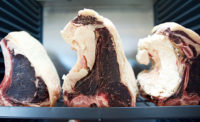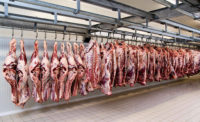Cattle supply is up and the beef processing industry is near capacity, which is certainly keeping processors busy. It also means facilities are using significantly more water, energy and sanitation chemistry.
Beef processors need to manage use of these resources to control costs while meeting the company’s internal energy efficiency and sustainability goals.
Water, for example, is gradually becoming more costly and scarce, making it a commodity that deserves close attention. You pay to bring it into your plant, to heat it, treat it and send it down the drain. Plus, drought conditions in certain areas of the country are prompting stricter standards around water usage for some operations.
On the harvest floor, cabinets for the carcass wash and head and tongue wash are the two largest consumers of water. When you consider the price per pound, or how much meat is fabricated compared to gallons of water used, the head wash is the biggest offender. The carcass wash, however, uses a higher volume of water. These cabinets go through 250 to 300 gallons per minute (GPM).
Fortunately for beef processors, there are ways to conserve water and ensure it is used most effectively.
First, conduct a thorough investigation of your head and carcass washing cabinets. Are you using the right size nozzles? Can you adjust the volume and temperature levels of the water? Your plant will likely find opportunities to save on resources such as water in the details.
I strongly suggest cabinets have regular preventive maintenance provided by an in-house team or third party. During maintenance checks, crews should closely examine the condition of nozzles.
Over time, nozzle orifices wear out and start passing more GPMs than necessary. Swapping out nozzles regularly saves a considerable amount of water, reducing associated costs. In a single shift plant, nozzles should be replaced yearly. Two shift plants should replace spray nozzles twice a year.
Swivel assemblies are another area to monitor. Third-shift sanitation crews tend to use carcass wash cabinet spray pipes as a ladder. When they do that, it often creates a kink in the swivel assembly, which will then start to leak. Make sure all swivels are tight and free of leaks.
Allowing maintenance crews to spend time checking out the cabinets for wear on spray arbors, nozzles and swivels is important. Many of the ways water gets wasted are preventable; your crews just need to spend the time looking for them.
A line you never want to cross is cutting back on resources in a way that jeopardizes food safety. You want to make sure you achieve as good or better results while using fewer resources.
That’s the big challenge, and it’s one being addressed by equipment manufacturers industry-wide. As we look to the future of beef processing, I believe you’ll see solutions enter the market that will apply water more efficiently and accurately thanks to major cabinet improvements. NP





Report Abusive Comment